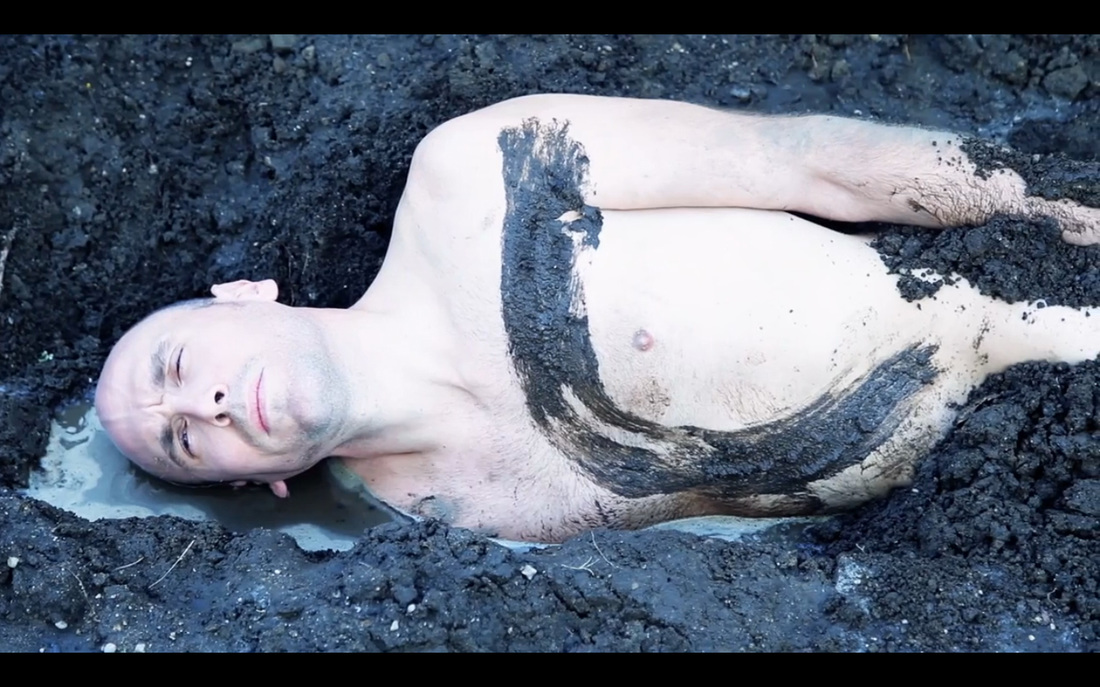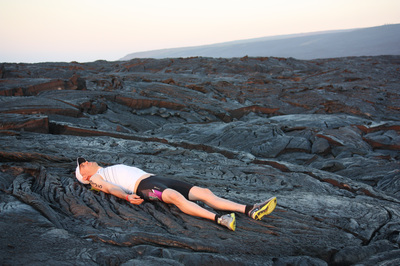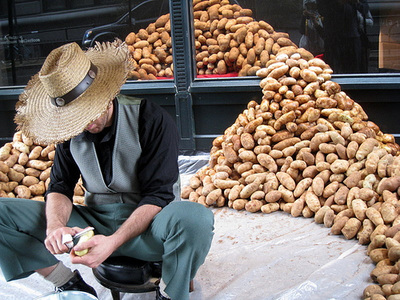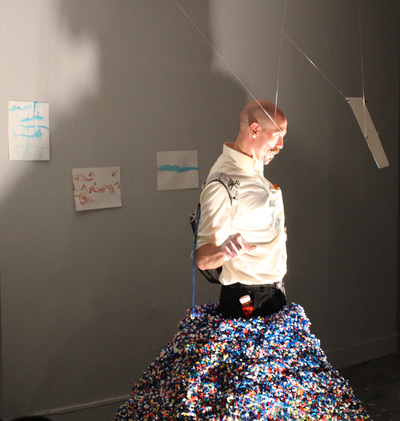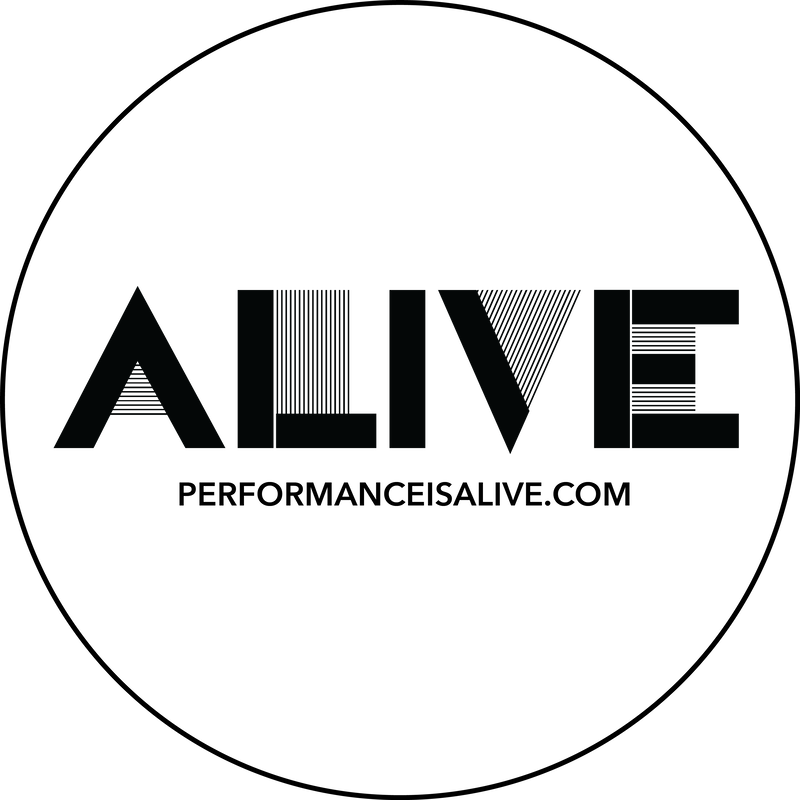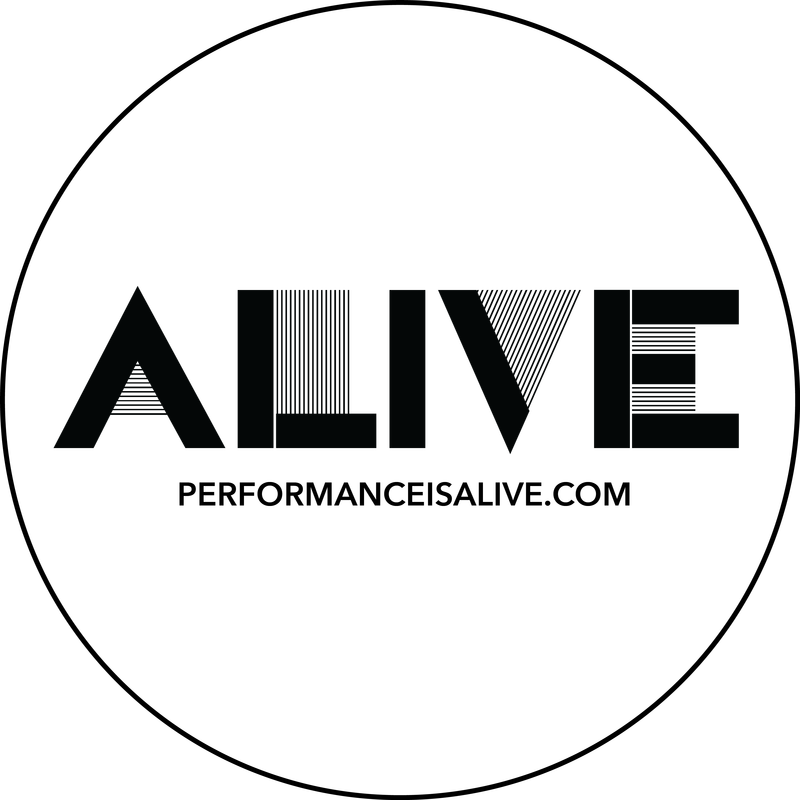|
Performance artists frequently occupy the blurred conceptual boundaries between art and life. Chun Hua Catherine Dong spoke to this nebulous territory in her Artist Feature stating "Performance has the capability to blur boundaries because it is live art that can happen at any place and any time - with or without audiences."
Weaving through the boundless art/life fusion requires tenacity and vulnerability, something distinctively present within JOHN BONAFEDE's performance works. Bonafede is a multi-disciplinary artist and curator based in New York City. For our next Artist Feature, Bonafede traces his performance art lineage extending from experimental theatre to social activism. He also discusses the compelling influences of curation and pronounced ties between athleticism and durational performance. Enjoy! - Quinn
QUINN DUKES: What led you to performance art?
JOHN BONAFEDE: Video was where the first turning point started to make itself clear. Using time-based media to make paintings, and watching the compositions evolve over the course of the piece was exciting. However, it was not enough for me. That same professor turned us on to Richard Foreman plays that led me to other experimental theater. That was compounded by the concepts swirling around what I had thought was a heady art, film and theater circles I found myself in when I was new to New York City in the mid 1990’s. A colleague at the time had shown me works of Marina Abramovic and I already was a fan of Yoko. So the confluence of what was relevant in contemporary painting combined with a love for extreme drama to create a heightened experience or convey a concept crept into my practice. My sculpture teacher, Alice Aycock, led a very experimental class at that time also. One day I showed up to it wearing, actually riding, a body puppet I made for a short video proposed to some musician friends. I found that wearing the costume across town from Alphabet City was the easiest way to get it to the critique in the Flat Iron District. On the way there, I saw the minds of children and adults alike being blown. So I really got into it. I was an athlete so being physically bold and pushing myself in that sweaty costume was not unlike sports gear I had performed well in. I tried acting and directing for a bit but it was not satisfying on the same level as my own performance art was. I did some student and independent films in the 1990’s, mostly through friends or friends of friends. I met some actors who were also very engaged in social political activity (ie: activism and documentary work) that led me to some street theater. On stage there was some Strindberg (Dream Play) and even the lead in Macbeth in an off Broadway production at the Resistance Theater. Probably got that role because I didn’t really have anything to lose at the audition and just went wild with the text. However, after the run was over, I realized that the 54 pages of text I had committed to memory was a tyranny over my life in every way. I wanted my work and my ideas to regain sovereignty so I threw myself fully into the performance art and music nights I produced and often performed in called OPEN*. It all went down in a loft space in midtown that I had built out with some friends to be a sort of theater, once a month. I cut my teeth as a performer at these events, where a spirit of experimentation and collaboration was rife. After over eight years of producing and performing in these I called it quits to producing. Focusing on my performance and its underlying concepts was difficult after fostering a community of interdisciplinary performers for such a long time. However, some of those influences and performers are still present in my work today.
QD: Are there performance artists working today that inspire your practice?
JB: Being blessed to consistently work with talented artists always inspires me. Not only performance art and artists inspire my performance art practice but yes, there have been some great ones who have left indelible marks on my practice. Alexander G Lyle IV (aka Nataraj) was a longtime collaborator in my pieces and still makes introspective work using his body’s interaction with specific environments in thoughtful ways. Working with Marina Abramovic for the big Museum Of Modern Art retrospective in 2010 definitely inspired me in some ways. Mostly about how to handle public nudity in my performance, personal space violations and group negotiations for fair treatment for performance artists from institutions. There were also some other talented performers in that Marina camp who are still influential colleagues today. Art Directing Shirin Neshat’s performance piece during Performa 2011 taught me about some different things as well. What “works” can be a matter of taste but sometimes experiencing what may be popular to an audience but what swerved away from my own practice can also be informative. Vest and Page, the duo out of Italy that performed in the same performance festival (Brooklyn International Performance Art Festival) I was part of in Brooklyn, had really brought me back to being hopeful about where performance could be heading. When the socio-political content of my performances go towards issues regarding environmental waste and our adverse affects on our ecosystem, the work of Chin Chih Yang comes to mind. In fact, I was once about to propose a piece that veered a little to close to a formal element of a piece of his that I saw months earlier, so I called him and told him my concerns. During that call, I worked out an alternative way that got my point across without stepping on Chin Chih’s visual syntax. My friend and colleague Jung Hee Choi influences me in obtuse ways. Her sound and light installations have spoken to my conceptual roots as a visual artist yet her “musical” performances with Lamont Young and Marian Zazzila, to this day speak to the spiritual side of performance work. Matthew Silver, in his total fearlessness and absurdity still appeals to my love for the surreal to cut through it all, getting core messages of love and unity back to the fore.
QD: Does ritual inspire your performance work?
JB: Growing up in a Catholic household, ritual performance was on display every Sunday at church and every dinner in the form of Grace. As a kid, I’d often cop some phrases and words from Mass and work them into comedic routines to make my family laugh. Ever since I researched Carlos Castaneda and got turned onto enigmatic rock music like the Doors and Jane’s Addiction, I always saw the boundary between ritual and theater as a blurred one. Having witnessed Buddhist rituals in Tibet and here in the States, and Japanese tea ceremonies, their influence on some of my work is obvious. Rite and ritual can be looked at in many ways. It was a ritual to make marinara sauce in my house every Sunday night that bordered on sacrosanct Italian heritage. Family is sacred so the act of consuming food with your clan was part of it. Shaving as a ritual appeared in my work several times. When I did Ironman triathlons I would have my race rituals that were borderline on superstitious. Depending on the person, brushing your teeth or shooting heroin could all be looked at as a daily ritual. However, one of my biggest fears in my own work and my biggest gripes with contemporary performance art is that there is this proto-performance artist attitude of ultra-seriousness, like that of a sacred ritual, which all-too-often makes performance work cliché. Stereotypes about performance art are easy to list; making a pseudo- ritualistic performance out of something mundane is right there near the top of the list. Sometimes, performers can pull it off if they are smart about it. However, I like to mix it up in my work. Maybe as I mature as an artist, I’m not so desperately trying to make my work with such a serious tone. With ritual there is little room for laughter- something I’ve come to value more and more in life and art. Most rituals command attention in a serious way, so if the net result or the conceptual content of the performance “ritual” does not have the gravity that I’ve come to expect from that sanctified mode of presentation, I get very disappointed. Assimilation is part of all mediums but if not truly lived, aping a serious ritual, even if it’s from one’s own culture, is an insult to real spiritual rituals that I respect a great deal. A practitioner of some ritual that brings that act into their performance retinue feels authentic from the start. It’s obvious. So I am careful as to what ritual practices I choose to inculcate. They must be lived first before I feel comfortable using them. QD: Do you find that curating performance events help to inspire your work? JB: Curating performance works has influenced me and continues to influence me. It’s funny because the ‘how’ it influences me is a somewhat mysterious thing. Sometimes I’d find that I’ll curate a Psychlotron* performance event with a performance artist who I adore and then forget about their work as far as my creative process goes. Then, sometimes years later, I’ll synthesize some ideas, movements or handle some material in a way that, in hindsight, had an element of said performer in that gesture. Curating Jung Hee Choi’s installation “Rice” in 2002, definitely influenced how I look at the potential for controlled environments. The goal of working here in NYC is to be exposed to so many types of performance work, whether I curate them or not, so that I can not even trace back where all the influences come from in my practice. With all I see and read, my head just pops and stuff comes out that may have traces of all sorts of peers and colleagues in it. I’ve been producing performance events since 1996 so there is bound to be things rubbing off on me. QD: How do you blur the boundaries between sports and art? JB: I blur the boundaries between sports and art similarly to how I blur the boundaries between art and life. It’s a contextual paradigm shift. Now, art is declarative so if we looked at nearly any action through a certain lens, we can see it as art. When I played or watched sports, announcers would talk or write about an athlete’s performance. That semantic nuance alone does not interest me but combined with certain elements of endurance performance work, the sports background does come into play. The body, as a vehicle for my compositions, should perform as the concept dictates. With some of my past endurance pieces, strength and resilience in the body and mind play a key element, as they do in sports. The Polymorph Series, which borrowed from the sports world their context and nomenclature of what could look and sound like art materials is an example of this. For example, using races like Iron Man, Mud Man, Timber Man, etc. took endurance events that could be a contemporary sculptor’s mediums and applied it to performance art. The metaphor of the body transforming into those elements or “mediums” upon the completion of each endurance performance (race) is the conceptual metamorphosis. The backdrop of the Iron Man triathlon happening within the NYC/NJ area, with its imposing iron infrastructure, or the mountainous woodlands of New Hampshire for the Timber Man triathlon, just added to the textural feeling of these performances. Sports usually require a certain grit to do them well. And I believe that can be learned, the hard way unfortunately. If one tries hard and fails a lot, they are bound to get better. Same kind of determination (or masochism) exists in my performance art. Not saying I am a tough guy but there is a bull-headed determination combined with thoughtfulness and skilled subtlety that I respect greatly in both art and sports. Let’s face it, we live in the “Western World” of beauty myths and standards. Since the ancient Greeks, the youthful, athletic build has been valued as more beautiful than others, especially in men. I enjoy the challenging of these concepts in regards to body politics and gender politics as well. I recently gained 44 lbs of fat for a performance as part of Armory Week 2015 to test this life and art overlapping in regards to my body and it’s functioning in a role I played. Point being, with conceptual art, beauty can be a dirty word depending on where one is coming from. It is all relative, of course. However, I am guilty of being raised in America and I love watching athletic bodies whose form follows their function. So as an amateur athlete, my triathlete body differed a bit from my high school football and lacrosse body because they had different daily functions and diets. Explosive, short-twitch muscle use bodies are not more beautiful than endurance sport bodies but each of their beauty lies in their ability to function in its given task. That beauty, along with what you do with an athletic body, is the honey that makes the spoon full of conceptual content go down a bit easier. I am not saying that I ever looked that good as say, an Olympic sprinter or gymnast in relation to their functionality but insofar as certain projects compelled me to be athletic, I welcomed the approach toward that kind of beauty and all its inherent benefits. However modest they are, athletic achievements bestow a certain confidence and one tends to feel better about themself than they did the day before they achieved that personal goal in sports. Confidence translates directly into performance art. Sports injuries also affect my performance work. Lasting damage can constrain new performances as well. Running marathons especially did a number on my knee, one ankle and a toe knuckle that I feel to this day. I’ll be old, flabby and wrinkly soon enough and definitely not fitting into that sporty beauty standard so I want to use athleticism while I can to perpetuate my performance and conceptual work. That said, I am not a big sports fan as far as watching them nor do I dismiss the myriad other types of beauty paradigms that exist in the world, especially the performance art world. SELECTED WORKS FROM JOHN BONAFEDE
Images and videos used with permission of the artist
Check out more from John Bonafede on the links below :
1 Comment
LB
12/21/2015 11:51:38 am
I have been following John's career for quite some time. Amazing artist and dedicated creator. Looking forward to more great things.
Reply
Your comment will be posted after it is approved.
Leave a Reply. |
CONTRIBUTORSIan Deleón Archives
July 2023
|
|
MISSION // Based in Brooklyn, NYC, PERFORMANCE IS ALIVE is an online platform featuring the work and words of current performance art practitioners. Through interviews, reviews, artists features, sponsorship and curatorial projects, we aim to support the performance community while offering an access point to the performance curious.
Performance Is Alive is a fiscally sponsored project of Fractured Atlas, a 501(c)(3) charity. Contributions made payable to Fractured Atlas for the purposes of Performance Is Alive are tax-deductible to the extent permitted by law. |
